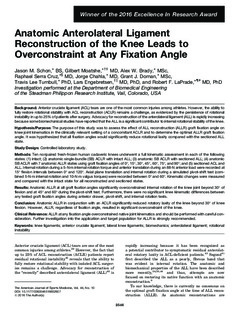Anatomic Anterolateral Ligament Reconstruction of the Knee Leads to Overconstraint at Any Fixation Angle
Schon, Jason M.; Moatshe, Gilbert; Brady, Alex W.; Cruz, Raphael Serra; Chahla, Jorge; Dornan, Grant J.; Turnbull, Travis Lee; Engebretsen, Lars; LaPrade, Robert F.
Journal article, Peer reviewed
Permanent lenke
http://hdl.handle.net/11250/2434654Utgivelsesdato
2016-07-12Metadata
Vis full innførselSamlinger
- Artikler / Articles [2119]
Originalversjon
The American Journal of Sports Medicine. 2016, 44, 2546-2556 10.1177/0363546516652607Sammendrag
Background: Anterior cruciate ligament (ACL) tears are one of the most common injuries among athletes. However, the ability to fully restore rotational stability with ACL reconstruction (ACLR) remains a challenge, as evidenced by the persistence of rotational instability in up to 25% of patients after surgery. Advocacy for reconstruction of the anterolateral ligament (ALL) is rapidly increasing because some biomechanical studies have reported that the ALL is a significant contributor to internal rotational stability of the knee. Hypothesis/Purpose: The purpose of this study was to assess the effect of ALL reconstruction (ALLR) graft fixation angle on knee joint kinematics in the clinically relevant setting of a concomitant ACLR and to determine the optimal ALLR graft fixation angle. It was hypothesized that all fixation angles would significantly reduce rotational laxity compared with the sectioned ALL state. Study Design: Controlled laboratory study. Methods: Ten nonpaired fresh-frozen human cadaveric knees underwent a full kinematic assessment in each of the following states: (1) intact; (2) anatomic single-bundle (SB) ACLR with intact ALL; (3) anatomic SB ACLR with sectioned ALL; (4) anatomic SB ACLR with 7 anatomic ALLR states using graft fixation angles of 0 , 15 , 30 , 45 , 60 , 75 , and 90 ; and (5) sectioned ACL and ALL. Internal rotation during a 5-N m internal rotation torque and anterior translation during an 88-N anterior load were recorded at 15 flexion intervals between 0 and 120 . Axial plane translation and internal rotation during a simulated pivot-shift test (combined 5-N m internal rotation and 10-N m valgus torques) were recorded between 0 and 60 . Kinematic changes were measured and compared with the intact state for all reconstructed and sectioned states. Results: Anatomic ALLR at all graft fixation angles significantly overconstrained internal rotation of the knee joint beyond 30 of flexion and at 45 and 60 during the pivot-shift test. Furthermore, there were no significant knee kinematic differences between any tested graft fixation angles during anterior drawer, pivot-shift, and internal rotation tests. Conclusion: Anatomic ALLR in conjunction with an ACLR significantly reduced rotatory laxity of the knee beyond 30 of knee flexion. However, ALLR, regardless of fixation angle, resulted in significant overconstraint of the knee. Clinical Relevance: ALLR at any fixation angle overconstrained native joint kinematics and should be performed with careful consideration. Further investigation into the application and target population for ALLR is strongly recommended.
Utgiver
SageTidsskrift
American Journal of Sports MedicineBeslektede innførsler
Viser innførsler beslektet ved tittel, forfatter og emneord.
-
Does surgery reduce knee osteoarthritis, meniscal injury and subsequent complications compared with non-surgery after ACL rupture with at least 10 years follow-up? A systematic review and meta-analysis
Lien-Iversen, Teodor; Morgan, Daniel Barklin; Jensen, Carsten; Risberg, May Arna; Engebretsen, Lars; Viberg, Bjarke (Peer reviewed; Journal article, 2019)Objective: We compared long-term follow-up from surgical versus non-surgical treatment of ACL rupture regarding radiographic knee osteoarthritis (OA), secondary surgery, laxity and patient-reported outcome measures ... -
Clinically Relevant Subgroups Among Athletes Who Have Ruptured Their Anterior Cruciate Ligaments: A Delaware-Oslo Cohort Study
Arhos, Elanna K.; Pohlig, Ryan T.; Di Stasi, Stephanie; Risberg, May Arna; Snyder-Mackler, Lynn; Silbernagel, Karin Grävare (Peer reviewed; Journal article, 2023)Objective: To identify subgroups of individuals with anterior cruciate ligament (ACL) injuries based on patient characteristics, self-reported outcomes, and functional performance at baseline, and to associate subgroups ... -
The role of the peripheral passive rotation stabilizers of the knee with intact collateral and cruciate ligaments: a biomechanical study
Vap, Alexander R.; Schon, Jason M.; Moatshe, Gilbert; Cruz, Raphael S.; Brady, Alex W.; Dornan, Grant J.; Turnbull, Travis Lee; LaPrade, Robert F. (Journal article; Peer reviewed, 2017-05)Background: A subset of patients have clinical internal and/or external knee rotational instability despite no apparent injury to the cruciate or collateral ligaments. Purpose/Hypothesis: The purpose of this study was to ...
